In Situ Mechanical Characterization of the Mixed-Mode Fracture Strength of the Cu/Si Interface for TSV Structures
Abstract
:1. Introduction
2. Materials and Sample Preparation
3. Nanoindentation Experiment
4. Analysis
4.1. Plastic Behavior of Cu
4.2. Micro-Cantilever Experiment
4.2.1. Failure Surface Characterization
4.2.2. Mixed-Mode Fracture
5. Results and Discussions
5.1. Strain Hardening of Cu Via
5.2. Mixed-Mode Cu/Si Interfacial Behavior
6. Conclusions
- (1)
- The mixed-mode fracture at the Cu/Si interface is brittle in nature. No significant cohesive zone was observed, nor does the plastic hinge that is typically found for the micro-cantilever beam consist of metal materials.
- (2)
- The effect of the plastic behavior of the Cu was negligible. The NLEFM analysis results showed that this is mostly due to the constrained plastic region, which was much smaller than the characteristic length (100 nm).
- (3)
- The vectorial fracture strength and toughness were obtained from the analysis, which indicated that the effect of the mode-mix was limited, which was suspected to be related to the constrained plastic zone.
- (4)
- A power-law fracture strength criterion could be used to fit the experimental data with close agreement. The criterion could be used for the design and engineering of TSV structures in combined loadings.
Author Contributions
Funding
Conflicts of Interest
References
- Garrou, P.; Bower, C.; Ramm, P. Handbook of 3D Integration, Volume 1: Technology and Applications of 3D Integrated Circuits; John Wiley & Son: Hoboken, NJ, USA, 2011. [Google Scholar]
- Jiang, T.; Im, J.; Huang, R.; Ho, P.S. Through-silicon via stress characteristics and reliability impact on 3D integrated circuits. MRS Bull. 2015, 40, 248–256. [Google Scholar]
- De Wolf, I.; Croes, K.; Pedriera, O.V.; Labie, R.; Redolfi, A.; Van De Peer, M.; Vanstreels, K.; Oroko, C.; Vandevelde, B.; Beyne, E. Cu pumping in TSVs: Effect of pre-CMP thermal budget. Microelectron. Reliab. 2011, 51, 1856–1859. [Google Scholar] [CrossRef]
- Heryanto, A.; Punta, W.N.; Trigg, A.; Gao, S.; Kwon, W.S.; Che, F.X.; Ang, F.X.; Wei, J.; Made, R.I.; Gan, C.L.; et al. Effect of copper TSV annealing on via protrusion for TSV wafer fabrication. J. Electron. Mater. 2012, 41, 2533–2542. [Google Scholar] [CrossRef]
- De Messemaeker, J.; Pedreira, O.V.; Vandevelde, B.; Philipsen, H.; De Wolf, I.; Beyne, E.; Croes, K. Impact of post-plating anneal and through-silicon via dimensions on Cu pumping. In Proceedings of the 2013 IEEE 63rd Electronic Components and Technology Conference, Las Vegas, NV, USA, 28–31 May 2013. [Google Scholar]
- Jiang, T.; Wu, C.; Im, J.; Huang, R.; Ho, P.S. Impact of grain structure and material properties on via extrusion in 3D interconnects. J. Microelectron. Electron Pack. 2015, 12, 118–122. [Google Scholar] [CrossRef]
- Jiang, T.; Wu, C.; Spinella, L.; Im, J.; Tamura, N.; Kunz, M.; Son, H.-Y.; Kim, B.G.; Huang, R.; Ho, P.S. Plasticity mechanism for copper extrusion in through-silicon vias for three-dimensional interconnects. Appl. Phys. Lett. 2013, 103, 211906. [Google Scholar] [CrossRef]
- Wu, C.; Huang, R.; Leitchi, K.M. Characterizing Interfacial Sliding of Through-Silicon-Via by Nano-Indentation. IEEE Trans. Device Mater. Relaib. 2017, 17, 355–363. [Google Scholar] [CrossRef]
- Wu, C.; Jiang, T.; Im, J.; Leichti, K.M.; Huang, R.; Ho, P.S. Material characterization and failure analysis of through-silicon vias. In Proceedings of the 21th International Symposium on the Physical and Failure Analysis of Integrated Circuits (IPFA), Marina Bay Sands, Singapore, 30 June–4 July 2014. [Google Scholar]
- Wu, C.; Taghvaee, T.; Wei, C.; Ghasemi, A.; Chen, G.; Leventis, N.; Gao, W. Multi-scale progressive failure mechanism and mechanical properties of nanofibrous polyurea aerogels. Soft Matter. 2018, 14, 7801–7808. [Google Scholar] [CrossRef]
- Li, Y.; Liao, Y.W.; Taghvaee, T.; Wu, C.; Ma, H.; Leventis, N. Bioinspired Strong Nanocellular Composite Prepared with Magnesium Phosphate Cement and Polyurea Aerogel. Mater. Lett. 2019, 237, 274–277. [Google Scholar] [CrossRef]
- Beegan, D.; Chowdhury, S.; Laugier, M.T. A nanoindentation study of copper films on oxidised silicon substrates. Surf. Coat. Technol. 2003, 176, 124–130. [Google Scholar] [CrossRef]
- Beegan, D.; Chowdhury, S.; Laugier, M.T. Comparison between nanoindentation and scratch test hardness (scratch hardness) values of copper thin films on oxidised silicon substrates. Surf. Coat. Technol. 2007, 201, 5804–5808. [Google Scholar] [CrossRef]
- Fang, T.-H.; Chang, W.-J. Nanomechanical properties of copper thin films on different substrates using the nanoindentation technique. Microelectron. Eng. 2003, 65, 231–238. [Google Scholar] [CrossRef]
- Carlsson, L.; Gillespie, J., Jr.; Pipes, R. On the analysis and design of the end notched flexure (ENF) specimen for mode II testing. J. Compos. Mter. 1986, 20, 594–604. [Google Scholar] [CrossRef]
- Chai, H. Experimental evaluation of mixed-mode fracture in adhesive bonds. Exp. Mech. 1992, 32, 296–303. [Google Scholar] [CrossRef]
- Dollhofer, J.; Beckert, W.; Lauke, B.; Schneider, K. Fracture mechanics characterization of mixed-mode toughness of thermoplast/glass interfaces (brittle/ductile interfacial mixed-mode fracture). J. Adhesion Sci. Technol. 2001, 15, 1559–1587. [Google Scholar] [CrossRef]
- Kfouri, A.; Brown, M. A fracture criterion for cracks under mixed-mode loading. Fatigue Fract. Eng. Mater. Struct. 1995, 18, 959–969. [Google Scholar] [CrossRef]
- Wu, C. Using Far-Field Measurements for Determining Mixed-Mode Interactions at Interfaces. Ph.D. Thesis, The University of Texas at Austin, Austin, TX, USA, 2017. [Google Scholar]
- Ramberg, W.; Osgood, W.R. Description of Stress-Strain Curves by Three Parameters; Technical note; National Advisory Committee for Aeronautics: Washington, DC, USA, 1943. [Google Scholar]
- Zhang, C.; Leng, Y.; Chen, J. Elastic and plastic behavior of plasma-sprayed hydroxyapatite coatings on a Ti–6Al–4 V substrate. Biomaterials 2001, 22, 1357–1363. [Google Scholar] [CrossRef]
- Lin, D.; Dimitriadis, E.; Horkay, F. Elasticity of rubber-like materials measured by AFM nanoindentation. Express Polym. Lett. 2007, 1, 576–584. [Google Scholar] [CrossRef] [Green Version]
- Albrecht, J.; Weissbach, M.; Auersperg, J.; Rzepka, S. Method for assessing the delamination risk in BEoL stacks around copper TSV applying nanoindentation and finite element simulation. In Proceedings of the 2017 IEEE 19th Electronics Packaging Technology Conference (EPTC), Singapore, 6–9 December 2017. [Google Scholar]
- Dundurs, J. Discussion of edge-bonded dissimilar orthogonal elastic wedges under normal and shear loading. J. Appl. Mech. 1969, 36, 650–652. [Google Scholar] [CrossRef]
- Hutchinson, J.W.; Suo, Z. Mixed mode cracking in layered materials. In Advances in Applied Mechanic; Elsevier: Amsterdam, The Netherlands, 1991; pp. 63–191. [Google Scholar]
- Aoki, S.; Kishimoto, K.; Sakata, M. Crack-tip stress and strain singularity in thermally loaded elastic-plastic material. J. Appl. Mech. 1981, 48, 428–429. [Google Scholar] [CrossRef]
- Kocks, U.; Mecking, H. Physics and phenomenology of strain hardening: The FCC case. Mater. Sci. 2003, 48, 171–273. [Google Scholar] [CrossRef]
- International Series on the Strength and Fracture of Materials and Structures. In International Series on the Strength and Fracture of Materials and Structures, Proceedings of the 8th International Conference on the Strength of Metals and Alloys, Tampere, Finland, 22–26 August 1988; Haasen, P.; Gerold, V.; Kostorz, G. (Eds.) Pergamon: Oxford, UK, 1988; p. ii. [Google Scholar]
- Mecking, H.; Kocks, U.; Hartig, C. Taylor factors in materials with many deformation modes. Scripta Mater. 1996, 35. [Google Scholar] [CrossRef]
- Kocks, U. The relation between polycrystal deformation and single-crystal deformation. Metall. Mater Trans. B 1970, 1, 1121–1143. [Google Scholar] [CrossRef]
- Tomé, C.; Kocks, U. The yield surface of hcp crystals. Acta Metall. 1985, 33, 603–621. [Google Scholar] [CrossRef]
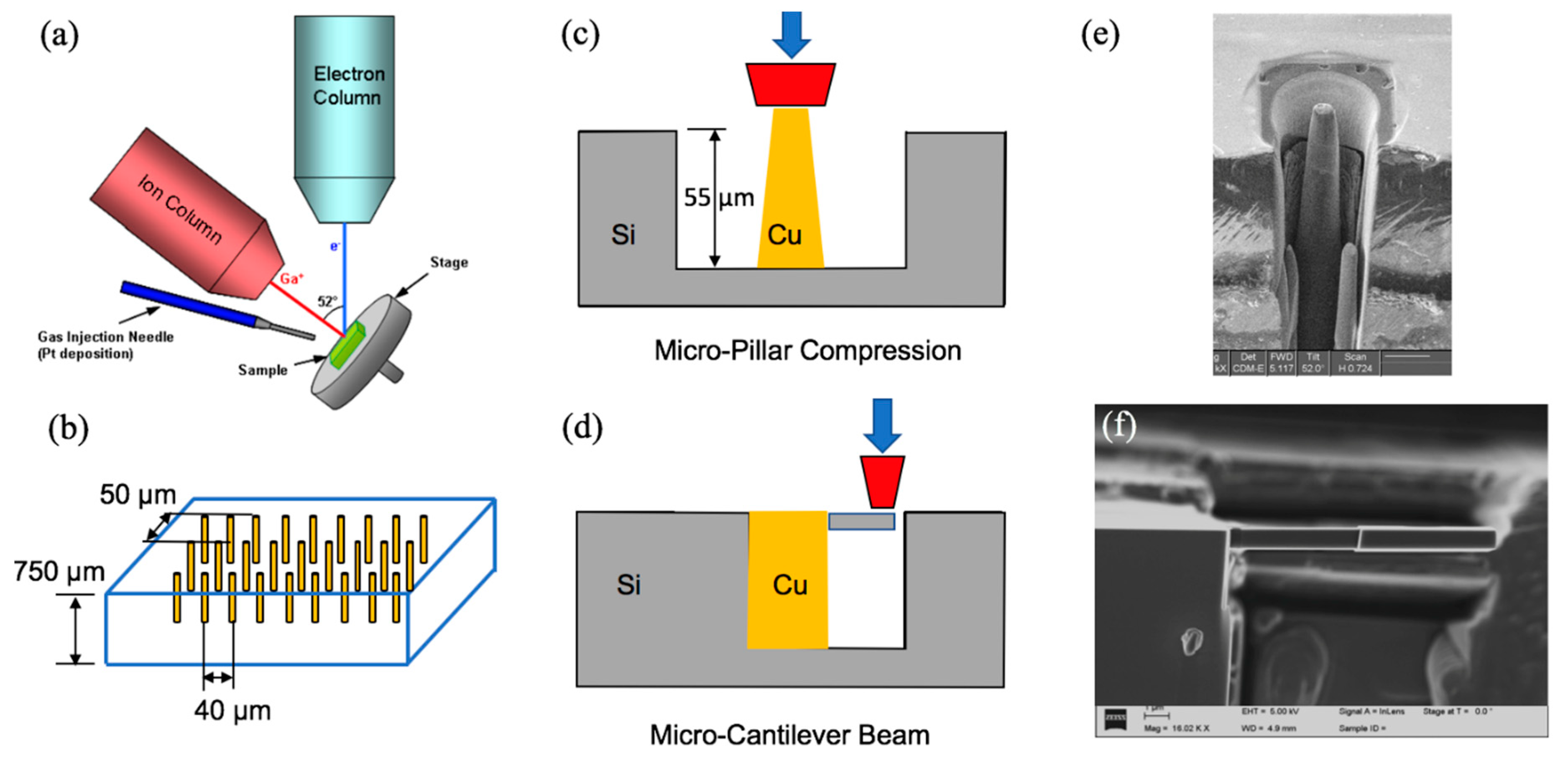
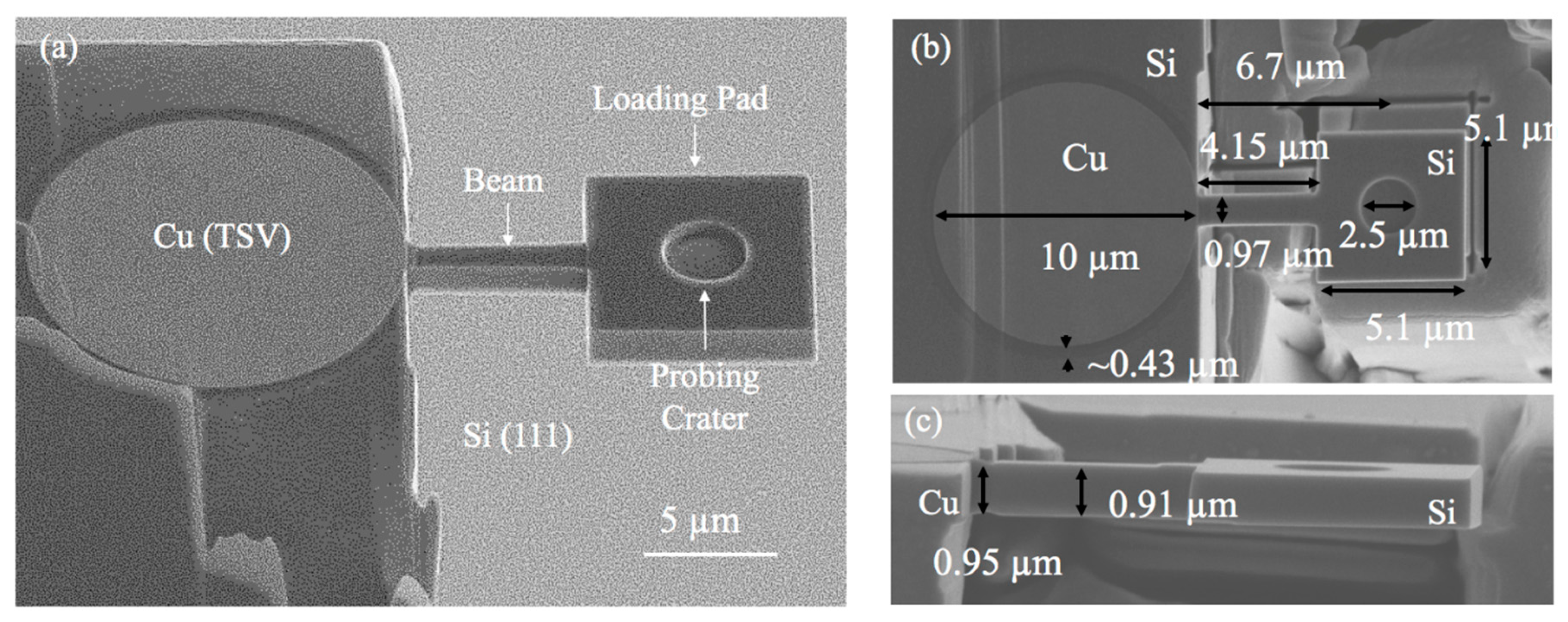

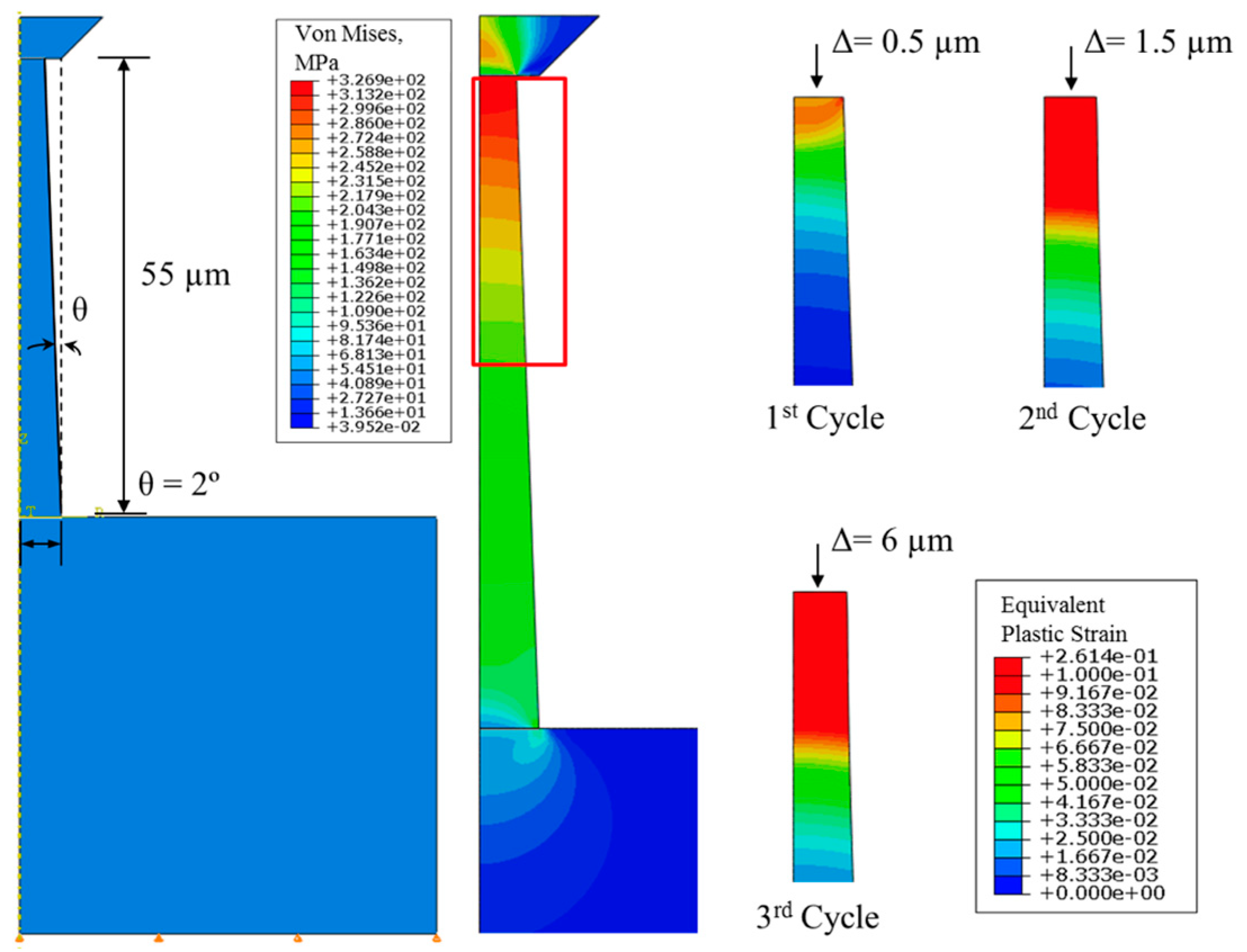

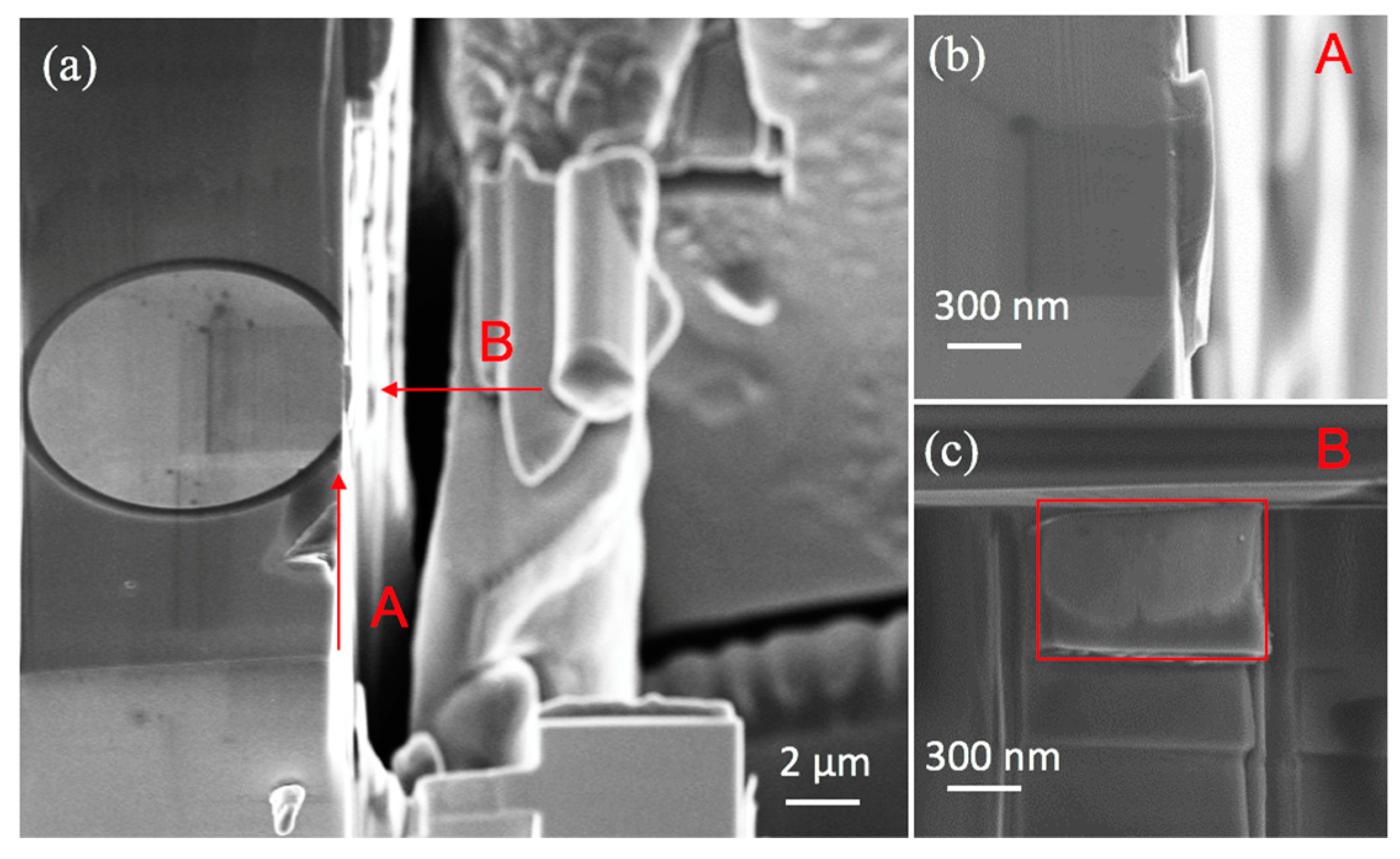
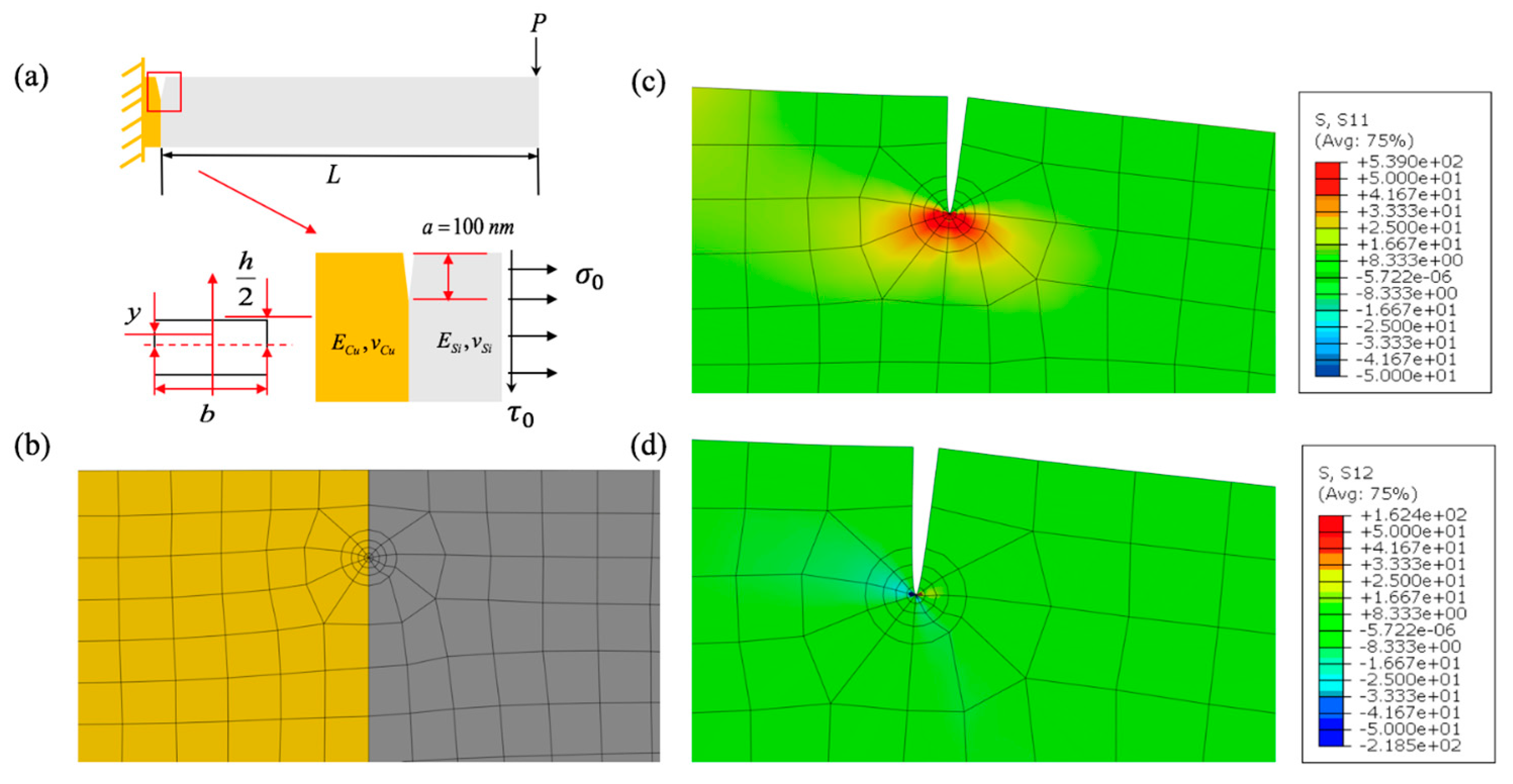



| Element | Weight % |
|---|---|
| Si | 5.62 |
| Fe | 0.02 |
| Cu | 84.34 |
| Ta | 1.04 |
| Os | 0.01 |
| L (µm) | (Degree) | (MPa) | (MPa) | T (MPa) | (J/m2) |
|---|---|---|---|---|---|
| 1 | 83.7 | 10.5 | 25.6 | 27.7 | 5.7 |
| 4 | 66.0 | 20.7 | 18.0 | 27.4 | 5.6 |
| 8 | 48.4 | 21.8 | 16.0 | 27.0 | 5.4 |
| 12 | 36.9 | 25.0 | 10.0 | 26.9 | 5.4 |
| 18 | 26.6 | 26.3 | 5.0 | 26.8 | 5.3 |
| 30 | 16.7 | 26.7 | 0.0 | 26.7 | 5.3 |
© 2019 by the authors. Licensee MDPI, Basel, Switzerland. This article is an open access article distributed under the terms and conditions of the Creative Commons Attribution (CC BY) license (http://creativecommons.org/licenses/by/4.0/).
Share and Cite
Wu, C.; Wei, C.; Li, Y. In Situ Mechanical Characterization of the Mixed-Mode Fracture Strength of the Cu/Si Interface for TSV Structures. Micromachines 2019, 10, 86. https://doi.org/10.3390/mi10020086
Wu C, Wei C, Li Y. In Situ Mechanical Characterization of the Mixed-Mode Fracture Strength of the Cu/Si Interface for TSV Structures. Micromachines. 2019; 10(2):86. https://doi.org/10.3390/mi10020086
Chicago/Turabian StyleWu, Chenglin, Congjie Wei, and Yanxiao Li. 2019. "In Situ Mechanical Characterization of the Mixed-Mode Fracture Strength of the Cu/Si Interface for TSV Structures" Micromachines 10, no. 2: 86. https://doi.org/10.3390/mi10020086
APA StyleWu, C., Wei, C., & Li, Y. (2019). In Situ Mechanical Characterization of the Mixed-Mode Fracture Strength of the Cu/Si Interface for TSV Structures. Micromachines, 10(2), 86. https://doi.org/10.3390/mi10020086





